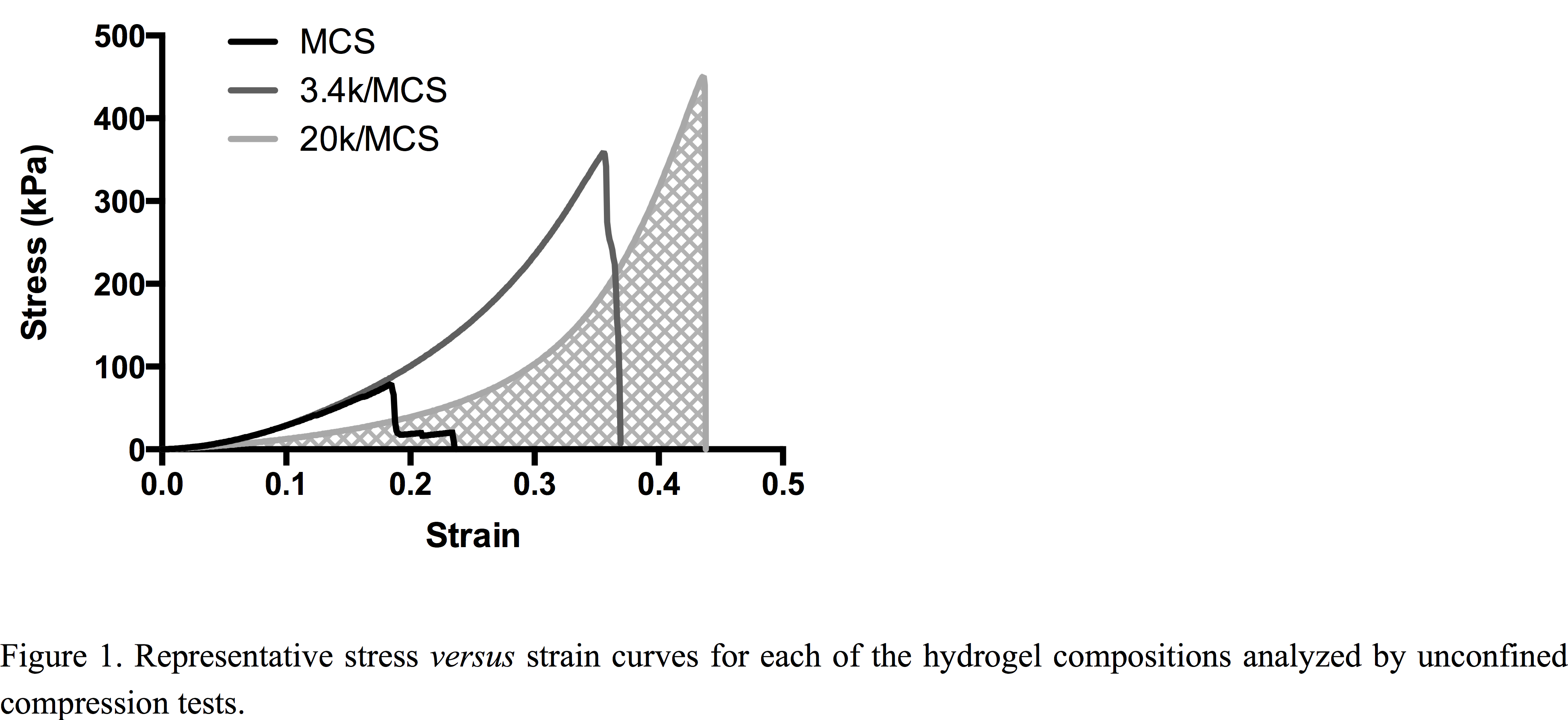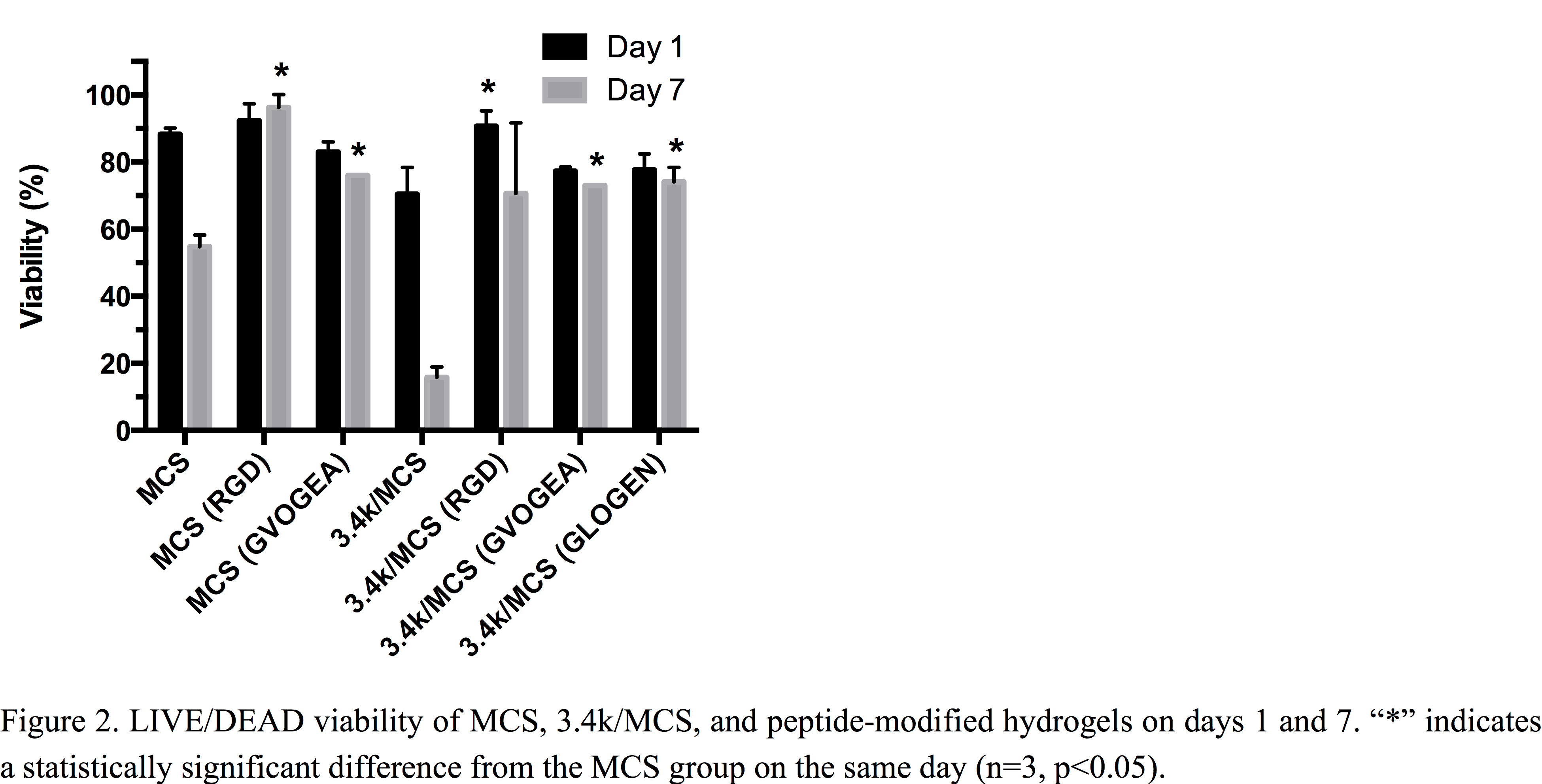Mechanically tunable hydrogels for delivery of adipose derived stem cells
-
1
Queen's University, Department of Chemical Engineering, Canada
-
2
University of Calgary, Department of Chemical Engineering, Canada
-
3
Western University, Department of Chemical and Biochemical Engineering, Canada
Introduction: Chondroitin sulphate is an important component GAG found in articular cartilage and has a chondroinductive effect on adipose derived stem cells (ASCs). Methacrylate chondroitin sulphate (MCS) has therefore been chosen as a basis for a polymer vehicle for ASC delivery for chondral defect repair. However, MCS lacks cell binding site as well as the required mechanical strength and swells extensively following crosslinking. To overcome these limitations, MCS was conjugated with the peptide sequences GVOGEA, GLOGEN, and GGRGDS, and blended with acrylated triblock copolymers of poly(ethylene glcol)-block-poly(trimethylene carbonate) (A-PTMC-PEG-PTMC-A) then crosslinked using a thermal initiator. The resulting gels were assessed for their mechanical properties and ability to retain encapsulated ASC viability.
Methods: CS was reacted with glycidyl methacrylate in aqueous medium and subsequently functionalized with peptides via EDC coupling. Triblock copolymers were obtained via melt polymerization of PEG diol (20 kDa, 3.4 kDa) and TMC (5:1 mol:mol TMC:PEG); triblocks prepared with 20kDa PEG are referred to as 20k, while those with 3.4kDa PEG 3.4k. The block copolymers were acrylated with acryloyl chloride and characterized by 1H-NMR spectroscopy. Gels were formed from prepolymer solutions using the APS/TEMED initiator system (10 mM) by heating blended prepolymer solutions from 20 to 37ºC. Gels containing the 3.4k or 20k triblocks were made using a 1:1 (w/w) blend of triblock and MCS for a total polymer content of 20 wt%. Gel mechanical properties were measured on a MACH-1 micromechanical system and bovine ASC viability following encapsulation was assessed via LIVE/DEAD staining, confocal imaging, and image analysis using Image J.
Results: The MCS had a methacrylation degree of 11%, while the triblocks had acrylation degrees of > 95%. The equilibrium water content of all hydrogels was greater than 90 wt%. In uniaxial compression, ultimate stress, strain and toughness increased with the fraction of triblock in the gels and with increasing triblock molecular weight; the MCS gels containing the 20k and 3.4k were elastic and could be strained to high degrees while the MCS gels were brittle (Fig. 1). Without peptide conjugated to the MCS, encapsulated ASC viability declined markedly from day 1 to 7, particularly in gels containing 3.4k triblock (Fig. 2). However, conjugation of any of the peptides assessed on the MCS resulted in retention of high ASC viability following thermally induced free radical encapsulation to day 7.


Conclusion: Hydrogels of high toughness and ultimate stress can be prepared by blending solutions of MCS with A-PTMC-PEG-PTMC-A. Conjugation of peptide ligands recognized by ASC integrins results in high ASC viability following encapsulation in gels prepared using the APS/TEMED initiator system. These gels have potential for minimally invasive ASC delivery for chondral defect repair.
Keywords:
Hydrogel,
3D scaffold,
Cell response,
mechanical property
Conference:
10th World Biomaterials Congress, Montréal, Canada, 17 May - 22 May, 2016.
Presentation Type:
New Frontier Oral
Topic:
Synthetic scaffolds as extracellular matrices
Citation:
Carroll
A,
Anjum
F,
Flynn
L and
Amsden
BG
(2016). Mechanically tunable hydrogels for delivery of adipose derived stem cells.
Front. Bioeng. Biotechnol.
Conference Abstract:
10th World Biomaterials Congress.
doi: 10.3389/conf.FBIOE.2016.01.02555
Copyright:
The abstracts in this collection have not been subject to any Frontiers peer review or checks, and are not endorsed by Frontiers.
They are made available through the Frontiers publishing platform as a service to conference organizers and presenters.
The copyright in the individual abstracts is owned by the author of each abstract or his/her employer unless otherwise stated.
Each abstract, as well as the collection of abstracts, are published under a Creative Commons CC-BY 4.0 (attribution) licence (https://creativecommons.org/licenses/by/4.0/) and may thus be reproduced, translated, adapted and be the subject of derivative works provided the authors and Frontiers are attributed.
For Frontiers’ terms and conditions please see https://www.frontiersin.org/legal/terms-and-conditions.
Received:
27 Mar 2016;
Published Online:
30 Mar 2016.